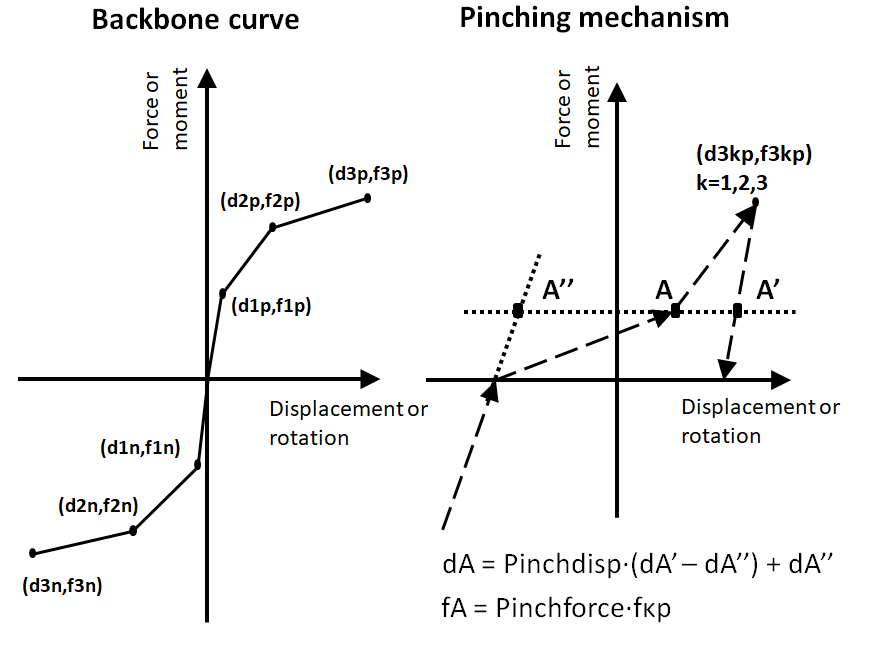Pinched asymmetric curve - pinched_asm
The pinched_asm curve is a uniaxial force-displacement model characterized by non-linear stiffness and strength deterioration rules and also by pinching of force and displacement. Deterioration because of damage due to ductility and energy may be added. The envelope curve of the model is defined by the user by supplying three force-displacement pairs for the positive branch and three force-displacement pairs for the negative branch of the envelope curve. Force and displacement must be given in ascending order for the positive branch and in descending order for the negative branch. In total, seventeen parameters must be defined in order to fully describe the mechanical characteristics of the material:
Displacement at first point of envelope in the positive direction (d1p(+))
The default value is 0.001
Force at first point of envelope in the positive direction (f1p(+))
The default value is 100.00
Displacement at second point of envelope in the positive direction (d2p(+))
The default value is 0.115
Force at second point of envelope in the positive direction (f2p(+))
The default value is 150
Displacement at third point of envelope in the positive direction (d3p(+))
The default value is 0.2
Force at third point of envelope in the positive direction (f3p(+))
The default value is 145.00
Displacement at first point of envelope in the negative direction (d1n(-))
The default value is -0.001
Force at first point of envelope in the negative direction (f1n(-))
The default value is -100.00
Displacement at second point of envelope in the negative direction (d2n(-))
The default value is -0.115
Force at second point of envelope in the negative direction (f2n(-))
The default value is -150.00
Displacement at third point of envelope in the negative direction (d3n(-))
The default value is -0.2
Force at third point of envelope in the negative direction (f3n(-))
The default value is -145.00
Pinching factor for displacement during reloading (pinchdis)
Controls pinching in the horizontal axis. The default value is 0.8
Pinching factor for force during reloading (pinchfprce)
Controls pinching in the horizontal axis. The default value is 0.2
Damage due to ductility (dam1)
This factor controls the damage due to ductility. In each loading cycle damage due to ductility can be employed producing a strength reduction proportional to the strain, meaning that higher strain leads to higher reduction. The higher the damage factor, the higher the damage. A damage due to ductility factor equal to zero disables this damage mode. The default value is 0.0
Damage due to Energy (dam2)
This factor controls the strength reduction due to energy. The reduction is proportional to the energy dissipated in the plastic region. Higher displacements combined with a high damage due to Energy factor and repeated cycles in the plastic region will result in higher damage. A damage due to energy factor equal to zero disables this damage mode. The default value is 0.0
Power used to determine the degraded unloading stiffness based on ductility (mu)
This variable controls the degradation of the unloading stiffness. A higher value leads to higher degradation. The default value is 0.0
